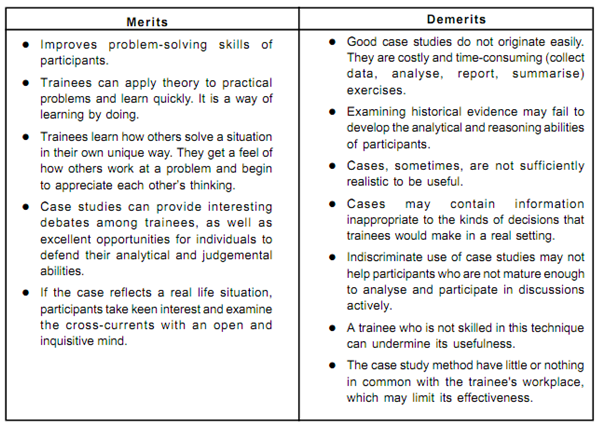Case Study
It is a training method that employs simulated business difficulty for trainees to solve. The specific is expected to learn the information given in the particular case and take decisions depend on the situation. If the student is providing a case involving real company, he is expected to research the firm to attain a better appreciation of its financial condition & corporate culture. The case method is used typically in the class room with an instructor who serves like a facilitator. Experienced trainers willingly point out that the case study is most suitable where:
- analytic, problem-solving and thinking skills are most vital.
- the KSAs are complicated & participants require time to master them.
- active participation is needed.
- the procedure of learning (questioning, interpreting etc.) is as significant as the content.
- team difficulty solving and interaction are possible.
Box 3: Merits and Demerits of the Case Study Method

The achievement of this method is closely related to the maturity and experience of the trainer who should facilitate the group's learning, keep applicant on track and help them see the underlying management concepts in the case obviously. Furthermore, it is also essential to come up with good case material depend on real life situations and present the similar before trainees in an interesting manner. While cases are meaningful and are similar to work associated situations, trainees may surely improve their decision-making skills and difficulty-solving abilities.
Box 4: When Using Case Studies
- Be obvious about learning goals and explore possible ways to realise the objectives.
- Explains which objectives would be best served by the case method.
- Discover the available cases that may work or consider developing your own.
- Set up the activity by including the case material, the room & the schedule
- view the principles that guide effective group interactions
- give an opportunity to all of the trainees to participate meaningfully and attempt to keep the groups small.
- Stop for procedure checks and get set to intervene while interactions go out of hand
- Allow for different learning styles
- explain the trainer's role as a facilitator
- Bridge the gap among theory & practice
|